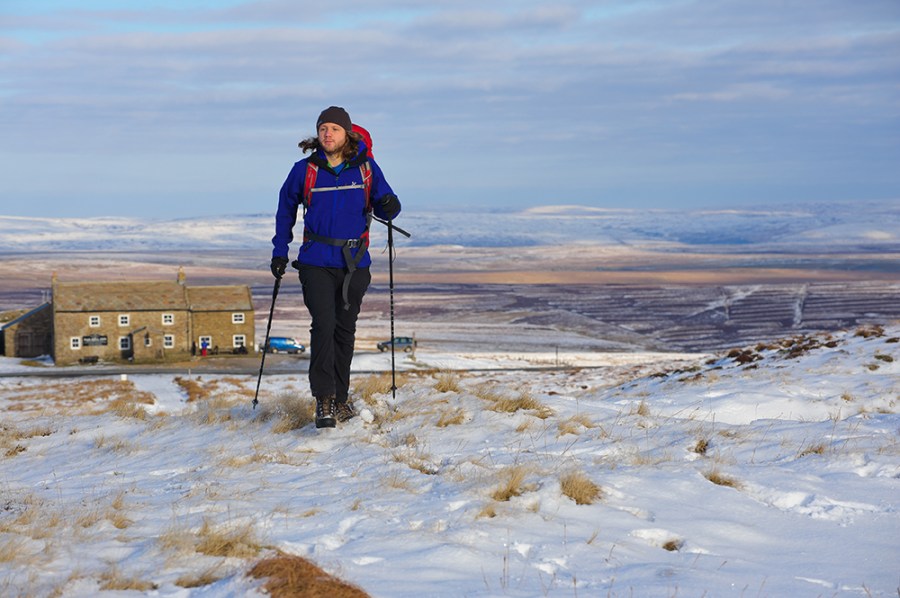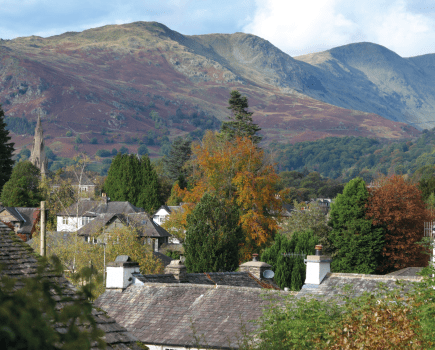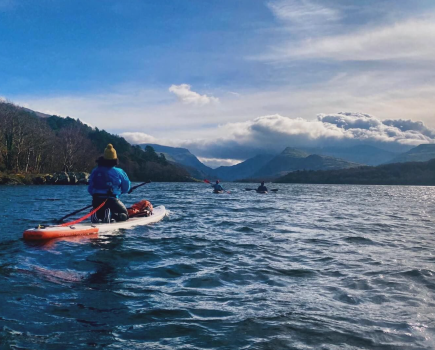When Carey Davies travelled to the famous Tan Hill Inn he expected a quiet couple of days walking. But he soon found out you get more than you bargain for at Britain’s highest pub
“You fat bastard.”
We’re high up in the forlorn far north of the Yorkshire Dales. The deserted, moonlit moor outside is plastered with snow. Grouse are quivering in heathery holes as the temperature falls past -5C. Here inside the incongruous glow of a coal fire-warmed pub, Tony, a murder detective from Bolton by trade, has just made the mistake of ordering some chips – after he’s already eaten dinner. The landlady of the pub gives him the above response.
“What do you want fucking chips for?” The landlady continues to shout over a packed bar which also includes a group of Geordie youth workers, a reporter and photographer from the Observer, two dogs, a pair of newborn lambs, a handful of locals, and some very baffled looking tourists. “I sweated blood to make you that dinner. Now you’re telling me you want chips!”
Tony protests that he’s been walking all day and is still hungry. The landlady calls him an ungrateful little shit. Tony’s face, already fairly puce with rage, is turning an alarmingly vibrant shade of beetroot. He looks like he might be about to burst.
Welcome to the Tan Hill Inn. The scene is typical; business booming, farm animals roaming free, an indignant customer wondering what they’ve done to deserve a constant stream of profanity-laden abuse, and members of the press trying to identify why such a fuss surrounds this exceptionally 17th century pub.
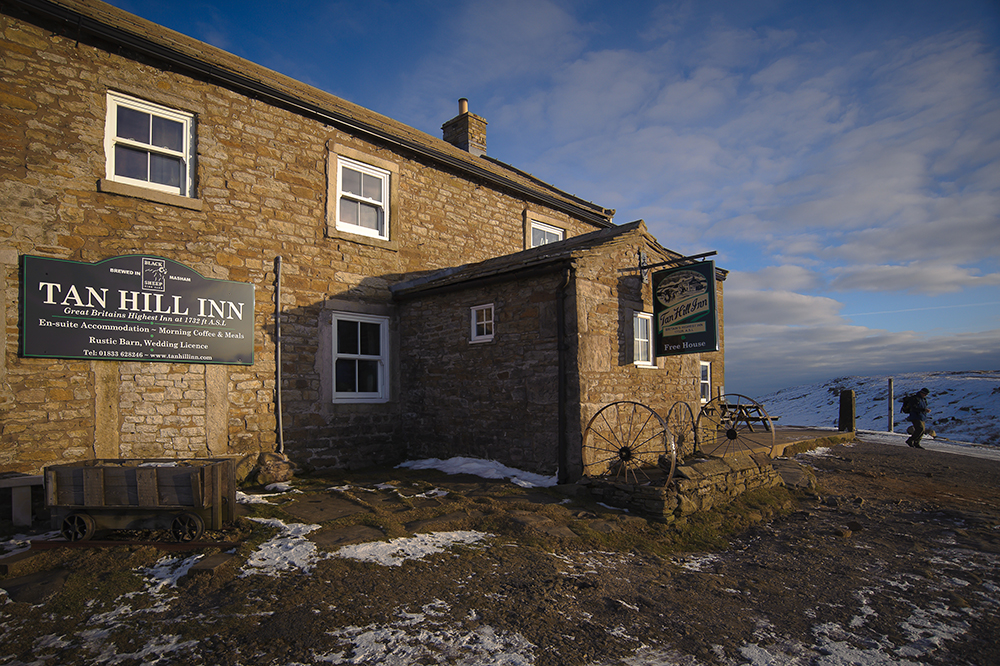
Tan Hill Inn. By Dave Willis
The swearing, at least, is easy to explain. It’s landlady Tracy Daly’s own unique way of making everyone feel welcome, and is doled in out in a perfectly egalitarian way to everyone who walks in the door. It’s not conventional, but – once the customer has got over their initial surprise/shock/outrage – it works.
The pub’s popularity is, on paper at least, harder to explain. This is not a location many conventional publicans would covet. At 528 metres (1,732 ft), it’s famous for being the highest pub in Britain. That height might not be a big deal if this was a balmy country with stable weather but up in the Pennines this is practically the Death Zone. The Tan Hill Inn has garnered a reputation for epic lock-ins like the one three New Years ago which ensued when the spaghetti-slim road leading to the nearest town, 11 miles away, became blocked by snow. It was three days before the captive guests – who, by all accounts, had a great time – were able to leave.
But the risk of being marooned on a desolate bit of Yorkshire moor doesn’t stop people coming. And therein lies the mystery of the Tan Hill Inn. Here is a pub a long way from anywhere on a patch of barren moorland, frequently cut off by weather, run by a foul-mouthed landlady liable to hurl grievous insults your way for the crime of asking for some peanuts. Yet trade is evidently at an all-time high.
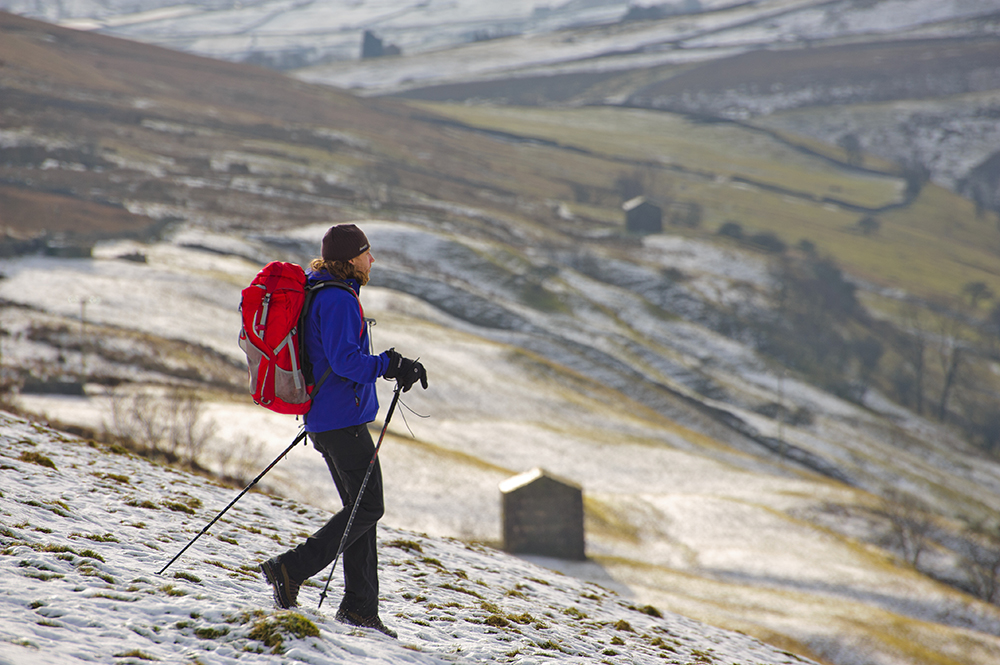
Keld, Swaledale, walking above Keld on the Pennine Way in winter. Dave Willis
Intrigued, I decided to pay it a visit. The Tan Hill Inn has been hosting walkers for decades thanks to the Pennine Way, which runs right past the door. But it also sits in the middle of some fabulously bleak upland country and it’s only a few miles south along the Pennine Way to Swaledale, among the quietest and most interesting of the Dales. I was anticipating a pleasant but uneventful couple of days strolling around history-studded moors and valleys. The reality, after I’d crawled gingerly in my car along a long, sinuous road over empty moors in the cold dark of a February night and arrived at the pub, would turn out to be slightly different.
Saturday
Tan Hill Inn to Muker and back, via Kisdon
Route: From the Tan Hill Inn join the signposted path of the Pennine way and set off south across Stonesdale Moor. Follow the path across the moor, staying on the Pennine Way, descending partly into West Stones Dale. Follow the Pennine Way through the gate on reaching High Frith. Descend into Swaledale until reaching Catrake Force. Cross the bridge and follow the path into Keld. Take the road south to Thwaite for 400m then turn left, following the track up Kisdon. Descend via this track to Muker. From Muker turn north and follow the path alongside the course of the River Swale along the base of the valley, going past Swinner Gill as you turn west. Eventually you will reach Catrake Force. Retrace your steps back across Stonesdale Moor to return to the Tan Hill Inn.
“The Great what magazine?”
“The Great Outdoors. TGO. I spoke to you earlier.”
“Oh yeh. I remember now. What do you want for dinner? I bet you’re one those bloody hippy vegetarians aren’t you. I can tell from your hair.”
It was an odd welcome. I was expecting the usual bland introductory pleasantries, but instead I was having my dietary habits and hairstyle mocked in one simultaneous blow. It wasn’t the only disorientating thing going on.
I had arrived on the same day as the lambs. Two tiny creatures were next to the fire. The larger was gamely trying to walk on young legs and clearly fascinated by its new environment. The other was desperately small and lay curled up silently on top of a cushion, wrapped in a blue blanket.
“They’re my pets,” explained Tracy. “We got them from a farm on Penrith today. Every year I get two lambs and they live in the pub until they’re old enough to be outside.”
I soon discovered that the traditional boundary between staff and customers doesn’t really exist at the Tan Hill Inn. “I spend most of my life running this pub. I’m not bloody pouring people drinks too,” said Tracy, when I asked for a beverage. “You can get it yourself. I make people make their own food too, you know. One man wrote on Tripadvisor that he came for Christmas Dinner and ended up cooking a meal for 14 people.”
And so I went behind the bar and attempted to pull my own pint of Black Sheep. It was a hit and miss attempt. But as the foaming head of the beer spilled haphazardly over the floor I realised I had stopped being confused and started to enjoy myself. There can be no formal airs and graces in a place where sheep trip you up on your way to the toilet, the landlady swears like Malcolm Tucker and the customers are free to wander behind the bar and help themselves to drinks. Dysfunctional? Maybe, but it’s hard not to feel relaxed – at least, once you’ve got used to the profanities.
Just then a group of half a dozen people enter the pub. “What the fuck do you want?” Tracy enquires of them.
***
The next morning dawned with sub zero temperatures and bright sun. I looked out my window and saw the view from the pub in daylight for the first time. A great empty plain stretched out below as far as the eye could see, interrupted only by the distant A66. It looked more like an Icelandic tundra than a Northern English grouse moor. The pub itself sat above the snowline on a dazzlingly white hillside.
Photographer Dave Willis joined me for a hearty breakfast before we swapped the warmth of the bar for the frigid but sunlit moorland air, joining the course of the Pennine Way with the intention of following it across Stonesdale Moor to reach Swaledale to our south. After only a short while the pub had disappeared and we found ourselves in the middle of a silent and wild landscape. Ten minutes after stepping out the door and here we were on the roof of the Pennines, surrounded by shining white hills with not a human feature in sight.
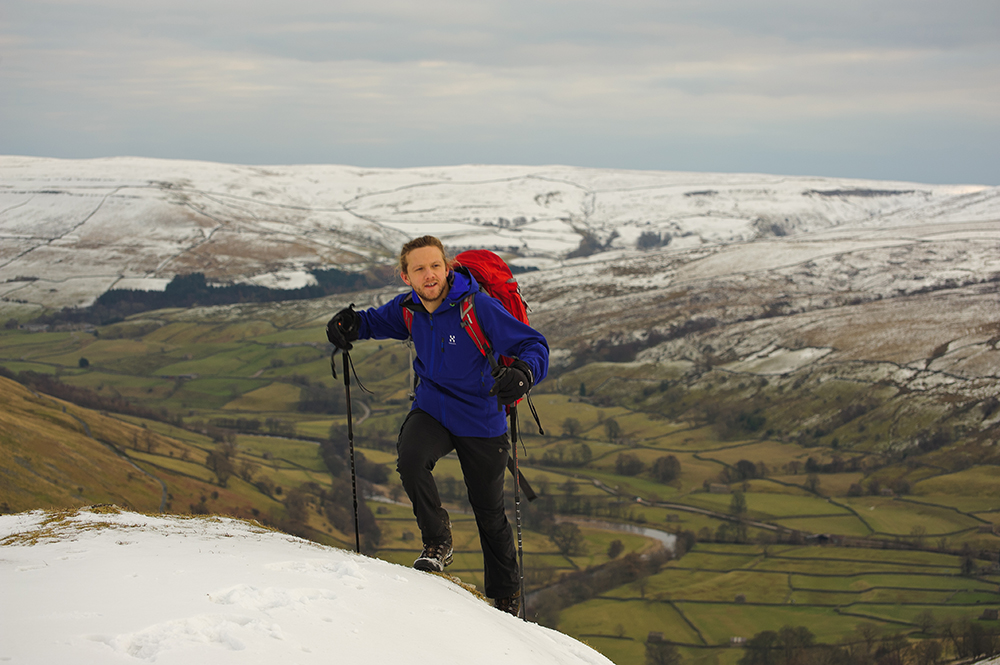
Walking on Kisdon, above Muker, Swaledale in the winter
We crunched across the four miles of moor and over the top of West Stonesdale, where signs of humanity in the form of barns, walls and fields started reappearing. Soon after, we reached the crest of the moor and found ourselves looking down over Swaledale.
Swaledale is a fascinating dry stone wall-patterned landscape of lone barns, miniature villages and, in spring, vibrant wild flower meadows. But at the heart of this scenic pearl is the grit of an industrial past that still lies scattered in and around the dale in the form of abandoned haulage, disused mine workings, half-collapsed chimneys and empty settlements, the wreckage of a lead mining effort that would have once enlisted thousands of people. The Tan Hill Inn has its origins in this industry, a pit pub that would have once served people employed in the many mine workings on Stonesdale Moor and beyond.
Swaledale’s comparative isolation and lack of any big peaks, gawp-inducing geology or ‘headline’ tourist sights keeps it relatively quiet compared to the likes of Upper Wharfedale, Malham or Three Peaks country. The appeal of Swaledale is something more elusive, a sense of remoteness in both place and time. This is an engineered landscape, chiselled into being over a dozen centuries by ploughs, walls and mining drills, but it remains dominated by nature, the spectacle of solitary barns on raw, empty hillsides or old mining villages collapsing back into the earth serving to highlight both the tenacity and the frailty of humankind’s grip on the landscape. This intertwining of history and nature is common in the Dales, but it is perhaps in Swaledale that the sense of it remains the most intact. This unique atmosphere no doubt helps explain why so many aficionados of the Dales, including Alfred Wainwright, cite it as their favourite.
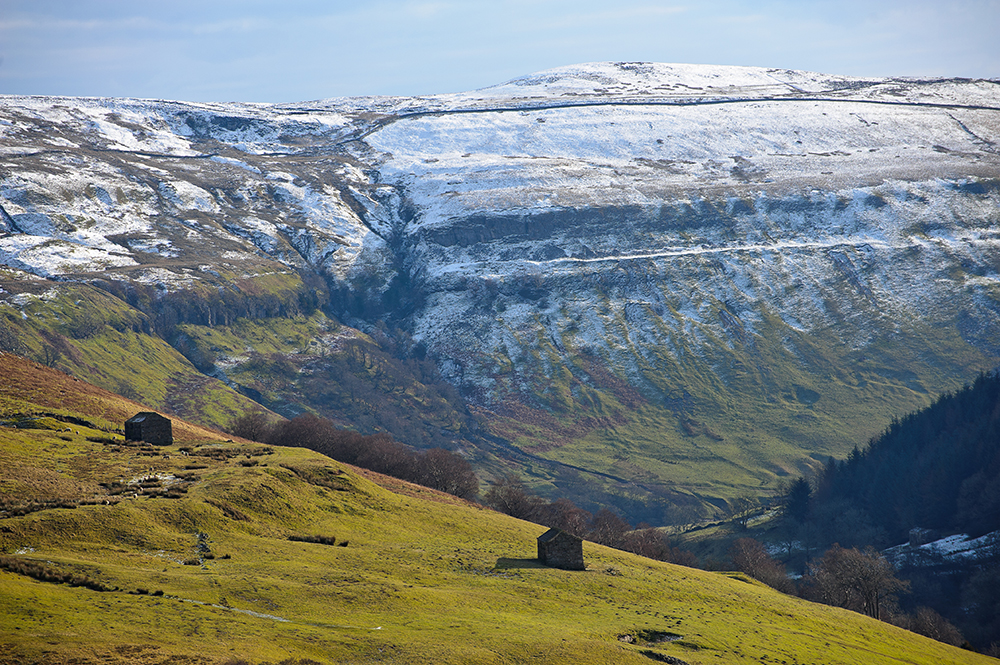
Keld, Swaledale, walking above Keld on the Pennine Way in winter
We descended from the moor into the bosom of the valley. The atmosphere of sheltered cosyness as we approached Catrake Force was a stark contrast with the bleak uplands we had just traversed. One of Swaledale’s many secluded waterfalls, Catrake Force was a scene of brittle beauty. Ice had gripped the margins of the falls, with long, dripping icicles hanging down from its overhanging steps and snowflake-patterned sheets of ice collecting in still pools and cracks beneath it. In a moment of childish enthusiasm I attempted to cross over the flow near where it met the River Swale, but succeeded only in getting cold and wet feet, much as I had done when I was actually a child.
We crossed the river via the drier means of a bridge and passed through the tiny village of Keld, one of a triangle of villages that surround Kisdon, a curious lump of a hill created by the carving action of glacial meltwater boring around its flanks and effectively splitting the flow of the valley into two, leaving Kisdon squatting in the middle of Swaledale like an island in a river.
Kisdon is therefore unusual in the Dales for being an isolated lump with no connection to the surrounding ridges. It also has no ‘official’ route to the top. Instead it is traversed by two rights of way, the Pennine Way to the east of its summit and the grisly-sounding Old Corpse Road to its west, so called because it was once used to transport – you guessed it – corpses from the top of the valley to consecrated valley lower down. I can’t think why the corpse bearers chose to lug their deceased carriage over the top of the hill rather than taking an easier course around it. But if they picked this route for its scenic qualities, which admittedly seems unlikely, they did a good job, a gentle gradient (the sort of thing you’d be thankful for if you were lugging a corpse) leading to the pleateau-like top of Kisdon then revealing wonderful views down a long section of Swaledale.
The views accompanied us all the way down to Muker, another exquisitely pretty stone village. From there we strolled back along the course of the River Swale and back to Catrake Force, passing below the ravine-like walls of the Kisdon Gorge, an unusually steep-sided valley by Dales standards.
On reaching Catrake Force we were then faced with the counter-intuitive task of walking back up and on to the moor to reach our starting point. This is the downside of any walk that starts from a high place and descends initially – it’s all fun and games to begin with, but sooner or later you have to repay your ‘downhill debt’, and a long ascent at the end of a walk is infinitely worse than getting it out of the way at the start of the walk when your legs are still fresh.
The beauty of the surrounding hills as the evening gave way to the moonlit night went someway to compensating for the grim effort as we climbed. But it was still a relief to see the Tan Hill Inn pop into view, an oasis of snugness in a cold and darkening landscape. It occurred to me how much of a godsend this sight would be to a weary traveller of yore or a desperate, disorientated walker in a Pennine blizzard.
And then how, on receiving the customary welcome from the inimitable Ms Daly, they might decide the blizzard wasn’t so bad after all.
Sunday
Industrial ruins on the moor around Great Pinseat
From the road follow the track north west on to the moor and past the shooting boxes on your left. Take care when you reach the spoil heaps above as the track splits in two. The left, lower track leads to a dead end; take the right fork, going round to the right hand side of the next spoilheaps you encounter and along the brow of the ridge. 200m after leaving the spoil heaps behind you need to navigate across the moor to the trigpoint at the summit of Great Pinseat and climb over the wall to reach the track on the other side. Descend to Flincher Gill and follow the track as it curves round, heading SE. Go straight on at Level House Bridge, and again continue straight on 200m later, avoiding the track left up on to the moor. Continue past the remains of Old Gang Smelting Mill until Surrender Bridge, then turn left on the road and return to your starting point.
By now, you may have gathered that the Tan Hill Inn is no ordinary pub. Its location, no doubt helped by the unconventional management style, produces the sort of experiences you simply wouldn’t have anywhere else. Travel there in the depths of winter, for example, and there is a good chance you’ll find yourself in a similar predicament to the 30 or so guests who woke up on a snowy New Years’ Day of 2010 to find themselves unable to leave (not that anyone minded too much – by the time the snow plough arrived three days later, the cellar was down to its last keg of beer.)
Then there’s the chance you might yourself treated to an impromptu set by a famous band of one sort or another. The Tan Hill Inn has seen gigs by the Arctic Monkeys, Mark Ronson and British Sea Power, and a few years ago hosted a 1,000 people-strong musical festival during which 90% of the cream of the UK’s indie music scene were reputed to be in attendance. There are rumours an even bigger name might be performing soon, so who knows who you might find yourself peeling potatoes in the kitchen with between sets.
The week before I arrived at the Tan Hill Inn, customers had been starstruck by a different phenomenon altogether – the pub made headlines for being one of the southernmost places in the world to view the northern lights, when a particularly active period of solar activity lit up the skies above the North Pennines.
An atmosphere of the unexpected surrounds this pub, which is one of the things that can make visiting it such an extraordinary experience. My own serendipitous monent happened on the second day of staying there. My plan was to head off after breakfast for a walk around Swaledale’s spectacular Gunnerside Ghyll. I had just packed the car, closed the boot and was ready to leave when some people arrived for lunch.
In a helicopter.
To cut a long story short, a little while later I found myself sitting inside said helicopter. The engine was charging up and the rotors overhead were spinning faster and faster.
Simon and Jonathan from Helicentre, a helicopter training centre in Liverpool, had kindly agreed to take me and Gary, a photographer from the Observer, for a spin. They had decided to fly that morning to take advantage of the excellent weather. “It was too nice a day not to fly,” Jonathan explained. “My family are from the Swaledale area so I knew about this place, and I thought why not go there for lunch?” Why not indeed?
Jonathan gave us a quick safety briefing and talked us through what to do if we “land unexpectedly.” Moments later we were airborne. A sun drenched, snow-covered landscape dropped away from us, and the far horizons opened up to reveal the ridges and valleys of the Yorkshire Dales. It was magnificent. The canyon-like proportions of Gunnerside Ghyll appeared below us, and instead of walking around it, I found myself flying through it. We soared over industrial ruins, hovered next to breathtaking waterfalls, and passed so low over one highly bemused walker I could see his face. Thankfully he was smiling, not shaking his fist and cursing these bloody aerial hooligans.
Back at the pub, the chopper touched down on the path of the Pennine Way to let me and Gary disembark. I wandered back to the pub in a daze and watched it fly again. Well, I thought, that’s one way to lunch in style.
Now there is, of course, no guarantee that you’d get an impromptu ride in a helicopter during a stay at the Tan Hill Inn. But how many other pubs is it even a possibility, however small? Or, for that matter, is seeing the northern lights, or quaffing a Theakstons with the Arctic Monkeys, or getting snowed in for three days and drinking the pub dry, or watching lambs playfight with Alsatians as you eat your steak pie? There was something about this pub, I’d decided. Perhaps it’s the deleterious effect of altitude, or the impact long-term isolation has on the human brain. Either way, I liked it.
Anyway, on with the walking. By now it was late in the day, and I found the even narrower road between the Tan Hill Inn and Keld, the most direct route to Swaledale, blocked by ice. So I abandoned the plan to walk in Gunnerside Ghyll – reasoning that I’d just seen it in a helicopter anyway – and went for Plan B, heading east to Arkengarthdale and a shorter walk taking in the abandoned industrial artefacts on the moors around Great Pinseat.
Still slightly buzzed from the helicopter, I made my way up from the childishly amusingly Moulds Bottom and began tramping across the moor. Long-abandoned skeletons of what were once mining vehicles and haulage equipment lay sunk in the snow, now as much of a part of the landscape as gritstone rocks, dry stone walls or the gargling sounds of grouse. Above me stretched a line of conical mounds, spoil heaps resulting from the excavation of what was once a rich lead seam called Martin Vein. I followed the line of these huge termite hills along the top of the ridge, gazing down over Arkengarthdale below.
From there I cut across to the trigpoint of Great Pinseat, deftly hidden behind a high dry stone wall, and rejoined the path at the top of Forefield Rake. Flawlessly clear sky stretched from horizon to horizon and the atmosphere was beautifully still. The weather in the Pennines in winter can be turbulent and hostile, but today it was the epitome of calm, a hushed stillness interrupted only by the crunching sounds of snow underfoot. The contrast with the noise and excitement of that morning couldn’t have been more pronounced. The only person I saw was a lone cyclist near the top of Forefield Rake.
The track descended through a Flincher Gill and Hard Level Gill, a gradually deeping valley, until it rounded a corner and revealed a striking sight. A large cluster of buildings including an intact chimney sat at the base of the valley. It was Old Gang Smelting Mill, once a churning industrial site, now a rather haunting and melancholy reminder of times past. On the moor just above the mill sat the bare remains of a kiln. The roof and doors had disappeared, leaving two parallel lines of stone pillars, gradually taking on the appearance of a Neolithic monument; a structure falling backwards through time as it decayed until the moment when the boundary between ‘man-made’ and natural would be gone altogether.
The path came back on to the road at Surrender Bridge. I don’t know why this bridge is so called – perhaps a reader could enlighten me – but it seemed an apt name in a place defined by things built by human endeavour that had long since given up their claim on the land.
And that was my visit to this wonderful part of the Yorkshire Dales over – nearly. Before I left I stopped by at the Tan Hill Inn one last time to return something I’d borrowed. As I did I said goodbye to the kind-hearted, indefatigable, outrageous Tracy Daly – but certainly not for the last time. I’ll definitely be back.
“Good,” she said, when I told her this. “Now piss off.”

